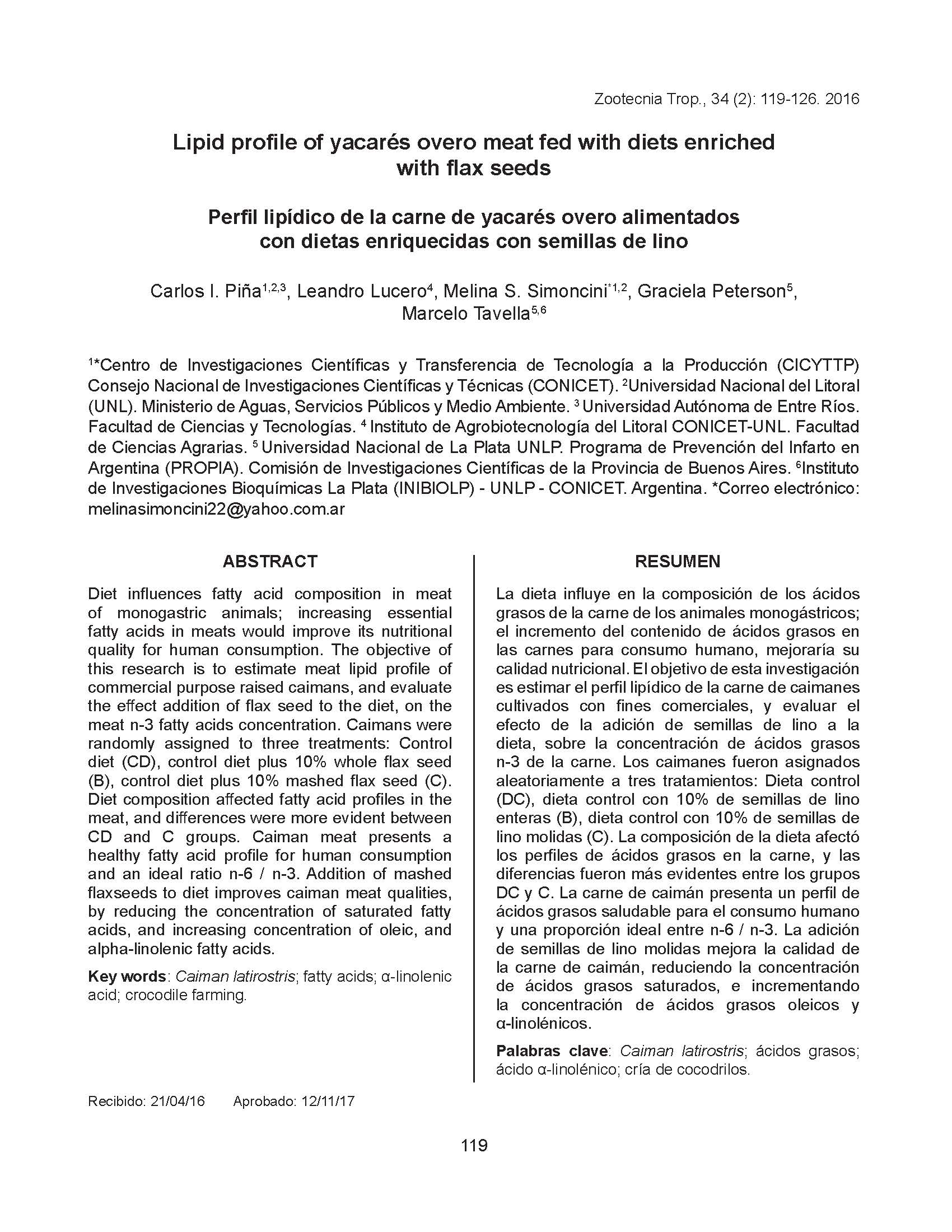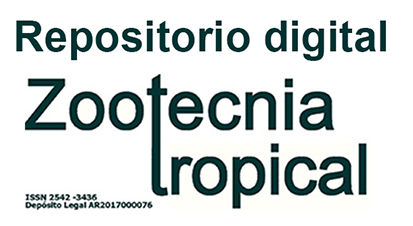Perfil lipídico de la carne de yacarés overo alimentados con dietas enriquecidas con semillas de lino
Resumen
La dieta influye en la composición de los ácidos grasos de la carne de los animales monogástricos; el incremento del contenido de ácidos grasos en las carnes para consumo humano, mejoraría su calidad nutricional. El objetivo de esta investigación es estimar el perfil lipídico de la carne de caimanes cultivados con fines comerciales, y evaluar el efecto de la adición de semillas de lino a la dieta, sobre la concentración de ácidos grasos n-3 de la carne. Los caimanes fueron asignados aleatoriamente a tres tratamientos: Dieta control (DC), dieta control con 10% de semillas de lino enteras (B), dieta control con 10% de semillas de lino molidas (C). La composición de la dieta afectó los perfiles de ácidos grasos en la carne, y las diferencias fueron más evidentes entre los grupos DC y C. La carne de caimán presenta un perfil de ácidos grasos saludable para el consumo humano y una proporción ideal entre n-6 / n-3. La adición de semillas de lino molidas mejora la calidad de la carne de caimán, reduciendo la concentración de ácidos grasos saturados, e incrementando la concentración de ácidos grasos oleicos y α-linolénicos.
Descargas
Citas
• Ayerza, R. and W. Coates. 2011. Protein content, oil content and fatty acid profiles as potential criteria to determine the origin of commercially grown chia (Salvia hispanica L.). Ind. Crop. Prod. 34:1366-1371.
• Baylin, A., X. Siles, A. Donovan-Palmer, X. Fernández and H. Campos. 2007. Fatty acid composition of Costa Rica foods including trans fatty acid content. J. Food Compos. Anal. 20:182-192.
• Calañas-Continente, A. J. y D. Bellido. 2006. Bases científicas de una alimentación saludable. Rev. Med. Univ. Navarra 50:7-14.
• Caldironi, H. A. and M. E. Manes. 2006. Proximate composition, fatty acids and cholesterol content of meat cuts from tegu lizard Tupinambis merianae J. Food Comp. Anal. 19:711-714.
• Coronado Herrera, M., S, R. Vega, Y. León, B. Gutiérrez Tolentino y G. Díaz González. 2006. Los ácidos grasos omega-3 y omega-6: Nutrición, Bioquímica y Salud. Reb. 25:72-79.
• De Caterina, R., A. Zampolli, S. Del Turco, R. Madonna and M. Massaro. 2006. Nutritional mechanisms that influence cardiovascular disease. J. Clin. Nutr. 83:421-427.
• De Lorgeril, M., P. Salen, J. L. Martin, I. Monjaud, J. Delaye and N. Mamelle. 1999. Mediterranean diet, traditional risk factors, and the rate of cardiovascular complications after myocardial infarction, Final report of the Lyon Diet Heart Study. Circulation 99:779-785.
• Depetris, G. J., F. J. Santini, E. Pavan, E. L. Villarreal, D. H. Rearte y N. A. Pensel. 2003. Efecto del grano de maíz alto en aceite en el sistema de engorde a corral: 3- Perfil de ácidos grasos de la carne. Rev. Arg. Prod. Anim. 23:60-61.
• Di Rienzo J. A., F. Casanoves, M. G. Balzarini, L. González, M. Tablada, C. y W. Robledo. 2017. InfoStat versión 2017. Grupo InfoStat FCA, Universidad Nacional de Córdoba, Argentina. Grupo InfoStat FCA, Universidad Nacional de Córdoba, Argentina. Disponible en línea: http://www.infosat.com.ar [Abr. 22, 2016].
• Dilzer, A. and Y. Park. 2012. Implication of conjugated linoleic acid (CLA) in human health. Crit. Rev. Food Sci. 52:488-513.
• Erener, G., N. Ocak and A. V. Garipoglu. 2007. The influence of dietary hazelnut kernel oil on the performance and fatty acid composition of broilers. J. Sci. Food Agr. 87:689-693.
• Fernández, T. J. R., R. C. Alves, T. Souza, J. M. G. Silva, M. Castro-Cunha, L. M. P. Valente and M. B. P. P. Oliveira. 2012. Lipid content and fatty acid profile of Senegalese sole (Solea senegalensis Kaup, 1858) juveniles as affected by feed containing different amounts of plant protein sources. Food Chem. 134:1337-1342.
• Folch, J., M. Lees and G. H. Sloane Stanley. 1957. A simple method for the isolation and purification of total lipides from animal tissues. J. Biol. Chem. 226:497-509.
• Harris, W. S. 2006. The omega-6/omega-3 ratio and cardiovascular disease risk: uses and abuses. Curr. Atheroscler. Rep. 8:453-459.
• Huchzermeyer, F. W. 2003. Crocodiles: Biology, Husbandry and Diseases. CABI Publishing, Wallingford.
• Jensen, K. N., C. Jacobsen and H. H. Nielsen. 2007. Fatty acid composition of herring (Clupea harengus L.) influence of time and place of catch on n-3 PUFA content. J. Sci. Food Agr. 87:710-718.
• Justi, K. C., C. Hayashi, J. V. Visentainer, N. E. Souza and M. Matsushita. 2003. The influence of feed supply time on the fatty acid profile of Nile tilapia (Oreochromis niloticus) fed on a diet enriched with n-3 fatty acids. Food Chem. 80:489-493.
• Lance, V. A., S. A. Morici, R. M. Elsey, E. D. Lund and A. R. Place. 2001. Hyperlipidemia and reproductive failure in captive-reared alligators: vitamin E, vitamin A, plasma lipids, fatty acids, and steroid hormones. Comp. Biochem. and Phys. part B. 128:285-294.
• Larriera, A. y A. Imhof. 2006. Proyecto Yacaré. Cosecha de huevos para la cría en granjas del género Caiman en la Argentina. In: M. L. Bolkovic y D. Ramadori (Eds.) Manejo de Fauna Silvestre en la Argentina. Programas de uso sustentable, Dirección de Fauna Silvestre, Secretaría de Ambiente y Desarrollo Sustentable. Buenos Aires, Argentina. pp. 51-64.
• Larriera, A., A. Imhof y P. Siroski. 2008. Estado actual de los programas de conservación y manejo del género Caiman en Argentina. In: J. Castroviejo, J. Ayarzaguena y A. Velasco (Eds.). Contribución al Conocimiento del género Caiman de Sudamérica, Publicación Asociación Amigos de Doñana 18. Sevilla, España. pp. 141-180.
• Mapiye, C., J. L. Aalhus, T. D. Turner, D. C. Rolland, J. A. Basarab, V. S. Baron, T. A. McAllister, H. C. Block, B. Uttaro, O. Lopez-Campos, S. D. Proctor and M. E. R. Dugan. 2013. Effects of feeding flaxseed or sunflower-seed in high-forage diets on beef production, quality and fatty acid composition. Meat Sci. 95:98-109.
• Maroof, Bahurmiz, O. and N. Wing-Keong. 2007. Effects of dietary palm oil source on growth, tissue fatty acid composition and nutrient digestibility of red hybrid tilapia, Oreochromis sp., raised from stocking to marketable size. Aquaculture 262:382-392.
• Mensink, R. P. and M. B. Katan. 1992. Effect of dietary fatty acids on serum lipids and lipoproteins. A meta- analysis of 27 trials. Arterioscl. Throm.Vas. Biol. 12:911-919.
• Molendi-Coste, V., I. Legry and A. Leclercq. 2011. Why and how meet n-3 PUFA dietary recommendations? Gastroenterol. Res. Pract. 2011:1-11.
• Maloney, A. P., C. Kennedy, F. Noci, F. J. Monahan and J. P. Kerry. 2012. Lipid and colour stability of M. longissimus muscle from lambs fed camelina or linseed as oil or seeds. Meat Sci. 92:1-7.
• Moreira, A. B., J. V. Visentainer, N. E. Souza and M. Matsushita. 2001. Fatty acids profile and cholesterol contents of three brazilian Brycon freshwater fishes. J. Food Compos. Anal. 14:565-574.
• Morel, P. C. H., J. Leong, W. G. M. Nuijten, R. W. Purchas and B. H. P. Wilkinson. 2013. Effect of lipid type on growth performance, meat quality and the content of long chain n−3 fatty acids in pork meat. Meat Sci. 95:151-159.
• Orton, H. D., N. J. Szabo, M. Clare-Salzler and J. M. Norris. 2008. Comparison between omega-3 and omega-6 polyunsaturated fatty acid intakes as assessed by a food frequency questionnaire and erythrocyte membrane fatty acid composition in young children. Eur. J. Clin. Nutr. 62:733-738.
• Phillipson, B. E., W. E. Connor, W. S. Harris and D. R. Illingworth. 1985. Reduction of plasma lipids, lipoproteins, and apoproteins by dietary fish oils in patients with hypertriglyceridemia. New Engl. J. Med. 312:1210-1216.
• Realini, C. E., S. K. Duckett, G. W. Brito, M. Dalla Rizza and D. De Mattos. 2004. Effects of pasture vs. concentrate feeding with or without antioxidants on carcass characteristics, fatty acid composition, and quality of uruguayan beef. Meat Sci. 66:567-577.
• Secretaría de Agricultura, Ganadería, Pesca y Alimentos. 2007. Análisis de producciones animales alternativas con potencial de desarrollo inmediato y mediato en la República Argentina. Secretaría de Agricultura, Ganadería, Pesca y Alimentos, Buenos Aires, Argentina.
• Shirai, N., H. Suzuki and R. Shimizu. 2004. Effect of rabu sea snake Laticauda semifasciata oil intake on maze-learning ability in mice. Fisheries Sci. 70:314-318.
• Simopoulos, A. P. 1991. Omega-3 fatty acids in health and disease and in growth and development. Am. J. Clin. Nutr. 54:(03)438-63.
• Surai, P. F. and N. H. C. Sparks. 2000. Tissue-specific fatty acid and alpha-tocopherol profiles in male chickens depending on dietary tuna oil and vitamin E provision. Poultry Sci. 79:1132-1142.
• Taha, A. Y., A. H. Metherel and K. D. Stark. 2012. Comparative analysis of standardized and common modifications of methods for lipid extraction for the determination of fatty acids. Food Chem. 134:427-433.
• Tavella, M. y G. Peterson. 2000. El Aceite de Girasol de Alto Oleico y la Prevención de la Aterosclerosis. Convenio DowAgro Sciences Argentina y la Universidad de La Plata, La Plata, Argentina.
• Trombetta, A., M. Maggiora, G. Martinasso, P. Cotogni, R. A. Canuto and G. Muzio, G. 2007. Arachidonic and docosahexaenoic acids reduce the growth of A549 human lung-tumor cells increasing lipid peroxidation and PPARs. Chem-Biol. Interact. 165:239-250.
• Urpi-Sarda, M., R. Casas, G. Chiva-Blanch, E. S. Romero-Mamani, P. Valderas-Martínez, S. Arranz, C. Andres-Lacueva, R. Llorach, A. Medina-Remón, R. M. Lamuela-Raventos and R. Estruch. 2012. Virgin olive oil and nuts as key foods of the Mediterranean diet effects on inflammatory biomarkers related to atherosclerosis. Pharmacol. Res. 65:577-583.
• Vicente-Neto, J., M. C. Bressan, P. Bitencourt Faria, J. Oliveira e Vieira, M. das G. Cardoso, M. B. de Abreu Glória and L. Telo da Gama. 2010. Fatty acid profiles in meat from Caiman yacare (Caiman crocodilus yacare) raised in the wild or in captivity. Meat Sci. 85:752-758.
• Visentainer, J. V., N. E. de Souza, M. Makoto, C. Hayashi and M. R. B. Franco. 2005. Influence of diets enriched with flaxseed oil on the α-linolenic, eicosapentaenoic and docosahexaenoic fatty acid in Nile tilapia (Oreochromis niloticus). Food Chem. 90:557-560.

Derechos de autor 2016 Carlos I. Piña, Leandro Lucero, Melina S. Simoncini, Graciela Peterson, Marcelo Tavella

Esta obra está bajo licencia internacional Creative Commons Reconocimiento-NoComercial-CompartirIgual 4.0.








